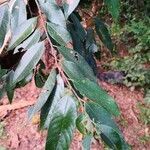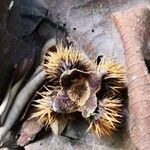It is a shrub or small tree. It grows to 12 m tall. The leafy structure near the leaves in narrow and 0.7-1.5 cm long. It falls off. The leaf stalk is 0.5-1.5 cm long. The leaf blade is oval and 6-14 cm long. There are yellow-brown scales underneath the leaf. The young leaves are also slightly hairy near the veins. The base is rounded, but wedge shaped when young. There are coarse teeth along the edge. The male flower is 5-12 cm long. The female flowers can occur singly or a few in a group. The cup is 3-5 cm across. It is covered with spine like bracts. There are 2-3 nuts per cup and they are 1.5-2 cm across.


